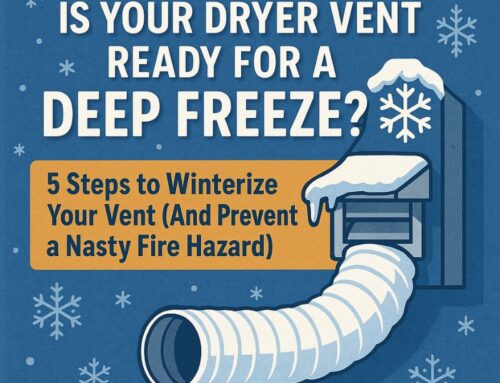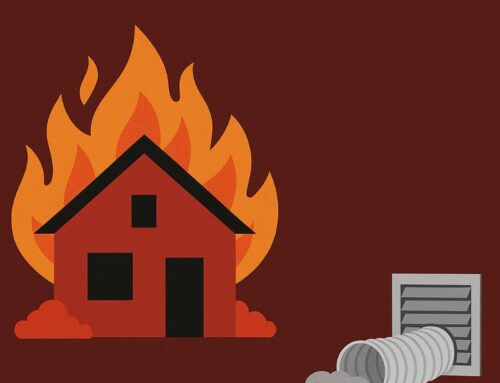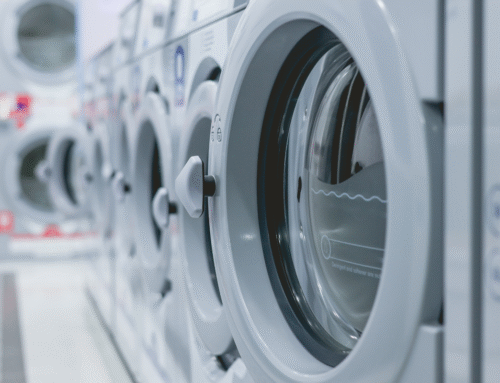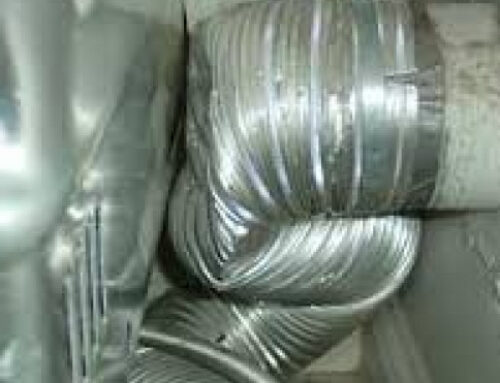How Often Should You Clean Your Dryer Vent? Don’t Ignore The Hidden Dangers
You know regular dryer vent cleaning prevents fire risk, but fire risk isn’t the only reason to keep your dryer vent clean. If you’ve noticed your clothes taking longer to dry, your energy bills creeping higher, or even a musty smell on freshly dried laundry, your clogged dryer vent could be silently costing you money and efficiency.
Over time, lint buildup forces your dryer to work harder, leading to higher energy consumption, costly repairs, and even premature breakdown.
So, how often should you clean your dryer vent? Experts recommend at least once a year, but depending on your laundry habits, you may need to do it more often. But how often? Read on to learn the warning signs of a potential fire, cleaning processes, professional vs. DIY options, and essential maintenance tips to keep your dryer running safely and efficiently.
Why Cleaning Your Dryer Vent Is Essential
Most people don’t think twice about tossing their laundry into the dryer, but what happens after you press “start” is more important than you might realize. Every time you dry your clothes, tiny fabric fibers break off, creating lint. While your dryer’s lint trap catches some of it, a significant amount sneaks past the filter and builds up in the vent system over time.
If left unchecked, this accumulation can create serious problems—including fire hazards, skyrocketing energy costs, and damage to your dryer.
Below, we’ll dive deep into why cleaning your dryer vent regularly is not just a suggestion, but an essential part of home maintenance, and you can decide if you need it professionally cleaned more than once a year.
Preventing Fire Hazards
Lint is highly flammable and according to the National Fire Protection Association (NFPA), dryer fires account for nearly 16,000 house fires each year in the U.S., with failure to clean the dryer vent being the leading cause.

When lint builds up in your dryer vent, it restricts airflow, causing the dryer to overheat. As temperatures rise, any trapped lint can ignite, quickly spreading flames through your home’s ductwork. These fires often start inside the walls, making them difficult to detect until it’s too late.
Regular dryer vent cleaning removes this hazard, dramatically reducing your risk of a house fire. If you’ve never cleaned your dryer vent—or can’t remember the last time you did—it’s time to make it a priority.
Boosting Energy Efficiency
Have you noticed your dryer taking longer than usual to dry clothes? When lint buildup blocks the airflow, your dryer has to work much harder to push moist air out. As a result, clothes take twice as long to dry, leading to excessive energy consumption.
The U.S. Department of Energy estimates that an average household spends around $100–$200 per year on drying clothes. However, a blocked dryer vent can increase energy usage by 30% or more. Cleaning your vent ensures proper airflow, allowing your dryer to operate efficiently, reduce drying time, and cut down on wasted energy.
Extending the Lifespan of Your Dryer
Your dryer is an expensive appliance, and like any machine, it performs best when it isn’t under unnecessary stress. When airflow is restricted due to lint buildup, your dryer is forced to work much harder than it was designed to. This extra strain leads to overheating, worn-out components, and even complete system failure.
One of the first parts to suffer from restricted airflow is the heating element working overtime to dry your clothes, leading to premature burnout. Additionally, the motor and belts inside your dryer can wear out faster when forced to compensate for poor ventilation.
Replacing a dryer can cost $500 to $2,000, while a professional vent cleaning costs a fraction of that. A routine maintenance schedule helps extend your dryer’s lifespan, protecting your investment and keeping it running smoothly for years.
Improving Indoor Air Quality
A clogged dryer vent doesn’t just affect your appliance—it can also impact the air you breathe inside your home. When the vent is blocked, excess heat and moisture have nowhere to escape, creating the perfect breeding ground for microbial growth and mildew.

This can lead to musty-smelling clothes, damp walls, and even health issues, especially for those with allergies or respiratory conditions.
For homes with gas dryers, the risks are even higher. A clogged vent can cause carbon monoxide (CO) to back up into your home instead of being safely vented outside. If you use a gas dryer, regular vent cleaning is absolutely critical for keeping your home safe from CO poisoning.
How Often Should You Clean Your Dryer Vent?
Dryer vent cleaning isn’t just a one-time task—it’s an ongoing part of home maintenance that should be done regularly to keep your home safe and your dryer running efficiently. But how often is “regularly”? Most experts recommend cleaning your dryer vent at least once a year, but this frequency can vary depending on several factors.
If you use your dryer frequently, have a long or complex vent system, or notice certain warning signs, you may need to clean it more often.
Professional Dryer Vent Recommendations: Every 6 to 12 Months
As a rule of thumb, dryer vents should be cleaned at least once a year to prevent lint buildup and ensure optimal performance. However, for households that do laundry frequently—especially those with large families, pets, or heavy fabrics—a cleaning every 6 months is a safer option.
Factors That Affect How Often You Should Clean Your Dryer Vent
1. Frequency of Dryer Use
The more you use your dryer, the faster lint accumulates. A single-person household that does laundry once a week will have significantly less buildup than a family of five who runs multiple loads daily. If you dry clothes several times a week, you should clean your vent every 6 months instead of once a year to prevent excessive lint accumulation.
Additionally, businesses that rely on commercial dryers—such as laundromats, salons, pet groomers, and hotels—should consider monthly cleanings. These high-usage machines generate an incredible amount of lint, making them more susceptible to blockages and fire hazards.
2. Type of Laundry and Fabric
Certain fabrics shed more lint than others. If you frequently dry towels, blankets, fleece, or cotton-heavy clothing, your vent will clog faster than if you mostly dry lightweight synthetics. The same applies if you have pets—pet hair can mix with lint, creating thick blockages that require more frequent cleaning.
Households that wash pet beds, plush toys, or heavy bedding should clean their vents at least twice a year. If you regularly wash athletic wear, delicate fabrics, or silk, you may be able to stick to an annual dryer vent cleaning schedule.
3. Length and Design of Your Dryer Vent System
The longer and more complex your venting system is, the more frequently it should be cleaned. Each bend in the vent creates a potential trap for lint, increasing the likelihood of clogs.
If your vent system is more than 5 feet long or has multiple turns, consider cleaning it every 6 months rather than once a year. If your vent is particularly difficult to access, hiring a professional to inspect and clean it is highly recommended.
4. Signs Your Dryer Vent Needs Cleaning
Even if you follow a routine cleaning schedule, there are certain warning signs that indicate your dryer vent needs immediate attention.
- Clothes take longer than usual to dry (more than one cycle)
- Dryer feels extremely hot to the touch after a cycle
- A burning smell coming from the dryer
- Excessive lint buildup around the lint trap or outside vent opening
- Musty smell on clothes after drying
- Visible lint or debris inside the vent hose
Expert Dryer Vent Cleaning & Maintenance Tips
Clean the Lint Trap After Every Load
- Remove lint from the filter before or after every load.
- Once a month, wash the lint screen with soapy water.
Use the Right Dryer Settings for Different Fabrics
- High heat cycles tend to create more lint, as extreme temperatures break down fabric fibers more quickly.
- Gentle or low-heat settings reduce fabric stress, helping clothes last longer and minimizing lint production.
- Air-drying heavy lint-producing items like towels, fleece blankets, and pet bedding can also reduce how much lint enters the vent system.
Inspect and Vacuum the Lint Trap Compartment Monthly
Inspect and vacuum this area at least once a month.
Keep the Dryer Vent Hose Short and Unobstructed
- The shorter and straighter the vent hose, the better the airflow, and the less likely lint is to get trapped.
- If you have a long vent system, consider installing a booster fan to improve airflow and reduce lint buildup over time.
Regularly Check the Outside Vent Opening
Check the outside vent opening regularly for clogged lint, leaves, or other debris and be sure to clean these items out.
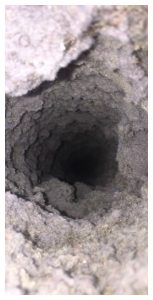
Avoid Overloading the Dryer
- Dry smaller loads to allow for better airflow.
- Shake out wet laundry before placing it in the dryer to prevent excessive wrinkling and clumping, which can trap lint.
- If you have a large load, split it into two smaller drying cycles to reduce strain on the vent system.
Schedule a Professional Dryer Vent Inspection Annually
During an inspection, a professional will:
- Use specialized equipment to remove deep lint buildup.
- Check for vent blockages or damage that could restrict airflow.
- Ensure your dryer vent system complies with safety regulations and isn’t at risk for leaks or obstructions.
If you use your dryer frequently or have a long, complex vent system, consider professional cleaning every 6 months to maintain optimal performance.
FAQs: Everything You Need to Know About Cleaning Your Dryer Vent
1. How Do I Know If My Dryer Vent Is Clogged?
The most obvious sign is if your clothes take longer than usual to dry, often requiring two or more cycles. Another key indicator is an excessively hot dryer—if the exterior of your machine or the laundry room feels unusually warm, it’s a sign that air isn’t escaping properly. You may also notice a burning smell, excessive lint accumulation around the vent, or even lint collecting inside the drum after a cycle.
2. Can a Clogged Dryer Vent Cause a Fire?
Yes, a clogged dryer vent is one of the leading causes of house fires. According to the National Fire Protection Association (NFPA), dryer fires account for approximately 16,000 fires each year in the U.S., with lint buildup being the primary cause.
When lint accumulates in the vent, it restricts airflow, causing heat to build up inside the dryer. This excess heat can ignite the highly flammable lint, sparking a fire that spreads quickly.
3. Is It Okay to Use a Dryer Without a Vent?
No, using a dryer without a vent is not safe. All dryers produce hot, moist air that needs to be expelled outside to prevent excessive humidity and heat buildup in your home. Without proper venting, moisture accumulates, leading to microbial growth, damage to walls and ceilings, and even structural issues over time.
This is especially dangerous for gas dryers, which also release carbon monoxide—a colorless, odorless gas that can be deadly in enclosed spaces.
4. What Happens If You Don’t Clean Your Dryer Vent?
Neglecting dryer vent cleaning can lead to a range of problems, starting with reduced efficiency. A clogged vent forces your dryer to work harder, increasing drying times and energy consumption. This not only raises your utility bills but also shortens the lifespan of your appliance, leading to costly repairs or premature replacement.
More seriously, failing to clean your vent puts your home at risk of fire. Lint is highly combustible, and when it accumulates in a restricted vent, the heat from the dryer can ignite it. Additionally, blocked vents can cause overheating, which may damage internal dryer components. Homeowners who ignore routine maintenance may also experience musty odors, excessive dust accumulation, and even carbon monoxide leaks in gas dryers.
5. How Can I Prevent My Dryer Vent from Clogging Quickly?
The most effective habit is cleaning the lint trap after every load. Even if it doesn’t appear full, small amounts of lint left behind can accumulate over time and make their way into the vent. Using dryer sheets and fabric softeners can also contribute to buildup, so consider alternatives like wool dryer balls.
Another key factor is ensuring your dryer vent is properly installed. Long, winding vent ducts with multiple bends are more prone to lint accumulation than short, straight ducts. Lastly, inspect the exterior vent regularly to ensure it’s not obstructed by debris, bird nests, or snow in colder months.
6. What is the Best Time to Clean Dryer Vents?
The “best time” to clean your dryer vents is now and regularly. While there isn’t really a designated “best” time to clean dryer vents, you will want to consider where the duct vents outside. For example, if it is on your roof, you may not want to clean it while snow or ice are on your roof.
So, What Will Be Your Dryer Vent Cleaning Frequency?
Answer: It depends, but you should have it professionally cleaned at least once a year. Keeping your dryer vent clean is one of the most important maintenance tasks you can do for your home.
Don’t Wait Until It’s Too Late! Take Action Now
Schedule your professional dryer vent cleaning today with Dryer Vent Techs. A clean dryer vent isn’t just about convenience—it’s about safety.



